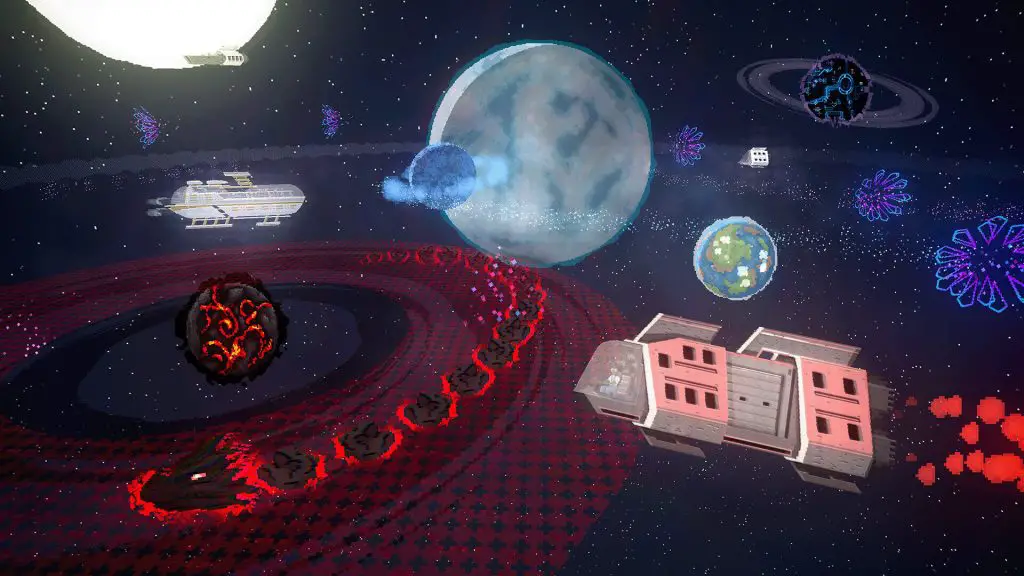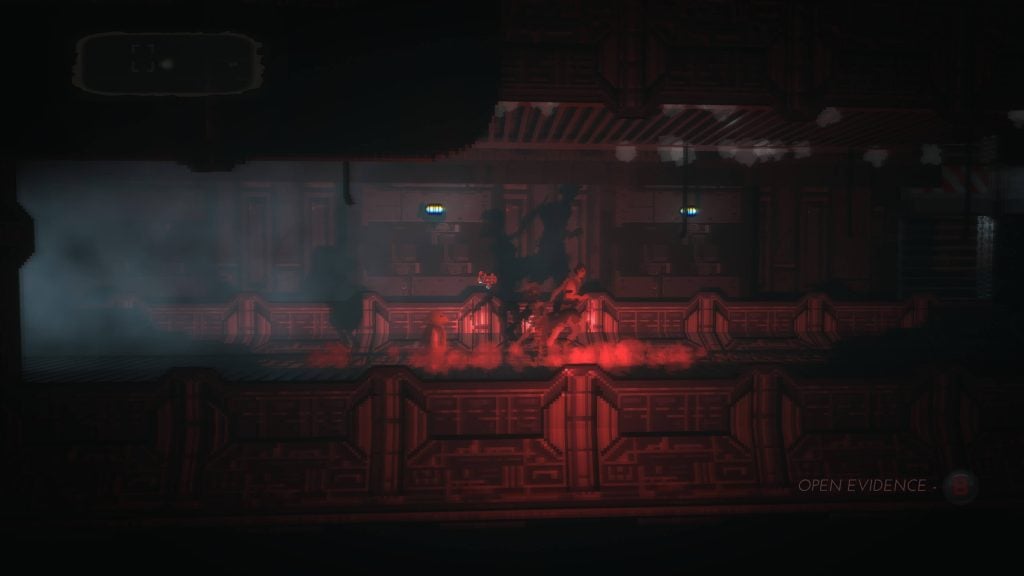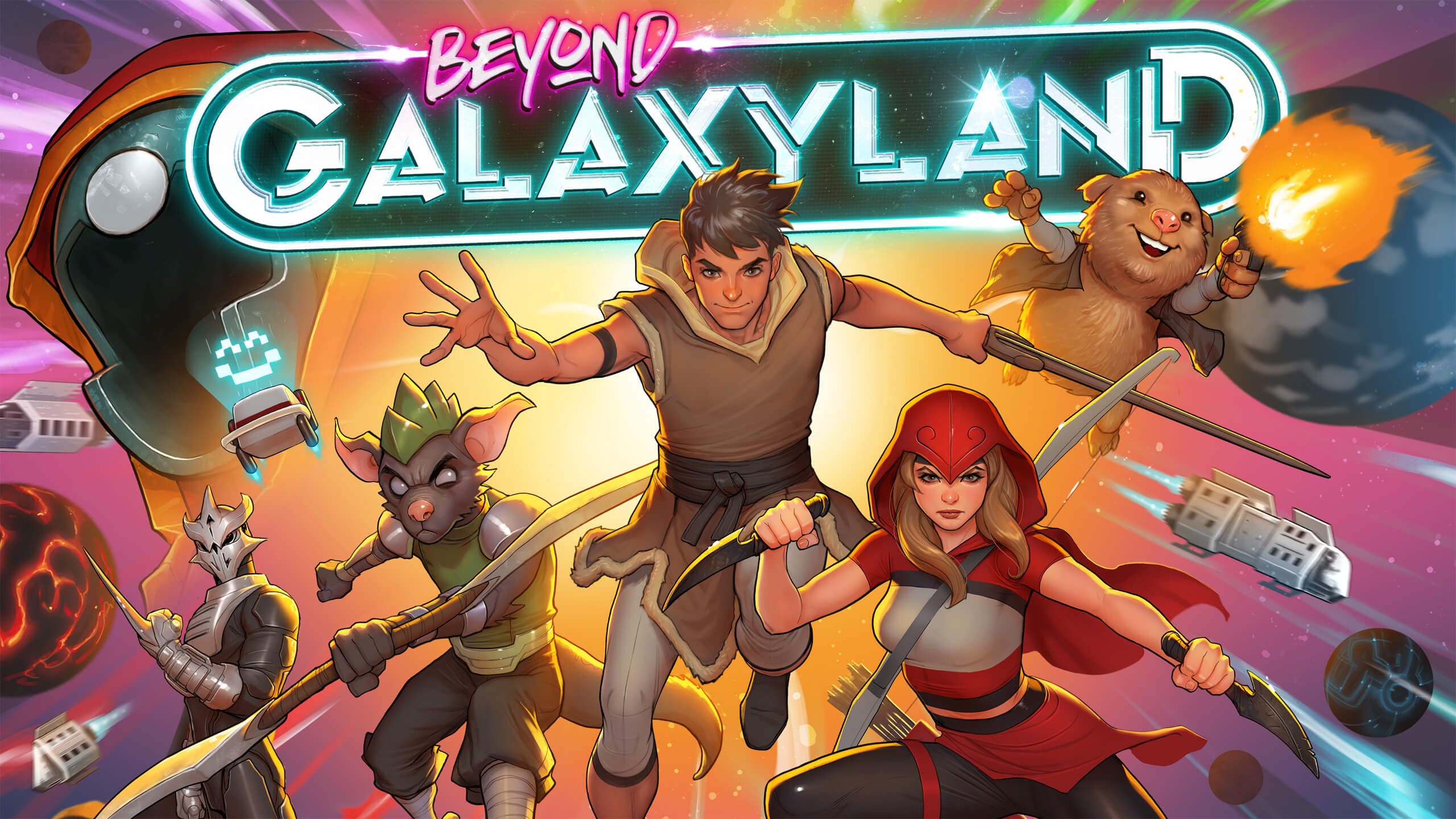Perhaps during the marketing phase leading up to the release, Beyond GalaxyLand flew a bit under the radar—though not for me, as I’ve been following its development and highlighted it long ago. That said, this brand-new space adventure, developed by solo dev Sam Enright and published by United Label, is now set to launch in just a few hours on PC via Steam, PlayStation, Xbox, and Nintendo Switch. Let me give you a few details on what you can expect from this title.
The Galaxies and an Unknown Threat
Let’s start with the game’s story. You play as Doug, an ordinary guy who suddenly finds himself thrown into a completely different planetary system—God only knows how many light years away from Earth—after an event known as “The End.” This mysterious entity has engulfed the Earth and seemingly destroyed it.

Confused and without direction, Doug can initially rely on Boom Boom (his pet guinea pig from Earth, who has now become a sentient, talking creature wielding a gun) and a small robot companion named Marty Bot, who acts as a guide and introduces him to this new galaxy.
Of course, I won’t go into more details to avoid spoilers, but I can tell you that there are several interesting characters you’ll encounter and be able to play as. The story unfolds in a very enjoyable way, keeping things fresh and engaging.
It proves you can tell a compelling narrative without drowning the player in a lot of text, which can sometimes feel overwhelming (trust me, I know the feeling). With that said, let’s dive into what Beyond GalaxyLand offers in terms of gameplay.
A 2D JRPG Platform
Sam Enright’s influences in the development of Beyond GalaxyLand are clear, especially with his love for JRPGs, and the game reflects that. It’s essentially a JRPG, but with a solid platforming element baked into the experience. Each planet and location you visit is designed in 2D, with layered environments featuring elevators, stairs, pathways, and buildings you can explore.
The exploration is quite engaging, filled with puzzle sections where you’ll need to activate switches, scale walls, and navigate classic platforming challenges. Doug can use a double jump to reach higher areas, clear debris with his sword slash, or use Boom Boom’s gun to uncover hidden bonuses scattered throughout the various locations you’ll traverse.

Another interesting feature that plays a role in both exploration and combat is your camera. You can use it to snap pictures of the different alien species you encounter, which can help complete quests and gather useful information about a particular enemy’s energy level and element affinity.
The exploration phase is well-executed, and even though the environments are in 2D, they feel immersive thanks to the game’s fantastic pixel art style. It instantly reminded me of Flashback—a nice nostalgic touch for fans of that classic.
The Combat And Summoning system
I previously mentioned the inspirations and influences from classic JRPGs, and Beyond GalaxyLand indeed features a combat system reminiscent of the Active Time Battle (ATB) from Final Fantasy. However, unlike traditional ATB systems, the action freezes when it’s your turn, giving you all the time you need to choose the best move.

Your options include standard attacks, abilities, summoning creatures, using items, swap party members and skipping a turn to gather ability points. But let’s break these down in more detail:
- Normal attacks utilize each character’s unique weapon. For Doug, this means a massive sword that can deliver multiple strikes in a single turn, with the number of attacks influenced by his equipment and accessories. These gear pieces don’t just increase attack count; they can also unlock special skills, such as scanning enemies (eliminating the need for the camera) or lowering enemy defenses, among other strategic options.
- Then, there are abilities—unique techniques for each character. These consume ability points (AP), and here’s where things get interesting: the AP bar is shared across the entire party. You can refill this bar through regular attacks or by choosing to skip a character’s turn to gather more AP.
- There are summons, which function as the game’s magic system. These are tied to various creatures you’ll encounter throughout your journey, and you can capture and use them in battle. Expect elemental variety—fire, ice, thunder, earth, dark matter, and light—each with its own strengths and weaknesses. Every summon has a max level of development, unlocking different spells as they grow. These spells consume the summoner’s SP (skill points) when cast in battle. The summoning system is incredibly compelling, and yes, you can even capture boss creatures, though they’re naturally much harder to obtain.
- Items that let you use all the consumables on yourself or party members.
- And finally, the ability to swap out a party member with someone from the bench without losing a turn.
During combat, timing is crucial for mitigating incoming attacks. You’ll need to press the defense button at just the right moment to block incoming attacks, minimizing damage. Beyond basic defense, you’ll also have to strategically use each character’s unique abilities to counter enemy techniques. For example, Boom Boom has a skill that can break through enemy defenses, allowing your party to deal normal damage again.
There’s also another character, whom you’ll meet later, with the ability to remove curses inflicted on your party members. Additionally, some characters have the ability to steal items from enemies, and many other skills add layers of strategy, keeping battles engaging and dynamic.
These mechanics ensure that combat never feels repetitive, as each encounter requires thoughtful use of abilities and timing to turn the tide in your favor.
Difficulty Level and Freedom of Action
Up until now (Chapter 2), I haven’t encountered any major difficulties in battles, mainly because I’ve been following the recommended quest order, sticking to the suggested level for each one. However, starting from the second chapter, things get a bit more challenging, with the risk of encountering fights that might be slightly above your current level due to the increased freedom of exploration.

After completing the first chapter, you’ll gain the ability to travel between planets and star systems, allowing you to pursue side quests or simply explore to level up your characters.
Each character has five main stats that increase with each level-up, influencing their performance in battle: Strength, Intelligence, HP, Summoning Points, and luck. This makes the characters fairly similar to one another stat-wise. The only way to truly enhance one stat over another is through relics—accessories that boost specific attributes. You’ll find plenty of these during exploration, especially by using the steal ability in boss fights.
Secondary Activities, mini-games And crafting
As mentioned earlier, Beyond GalaxyLand offers plenty of side quests, many of which you’ll need to postpone until your characters reach the required level. These quests are often unique and enjoyable, like one where you have to gather clues to unmask an assassin, or another where you search for spare parts across different planets. The variety here definitely adds depth to the game’s world.
Another activity that will keep you busy is your role as a space photographer. This ties not only into the combat system but also into completing your photo album and some quests that require you to capture specific creatures. As you progress, finding these subjects becomes increasingly difficult, making it a rewarding challenge for completionists who love 100%-ing games.

There’s also a crafting system that lets you create consumables and, more importantly, relics. While it’s nothing groundbreaking, crafting some of the more valuable items will require a bit of effort. Finally, there are a few fun mini-games like Boom Boom’s motorcycle races or spaceship races. These aren’t overly complex, but they provide a nice change of pace from the main gameplay.
Sounds and Graphic
Beyond GalaxyLand offers a unique journey accompanied by a soundtrack that I truly appreciated. The background music during cutscenes and exploration keeps a lively beat, reminding players of the game’s lighthearted tone. However, when the more emotional moments hit (and there are plenty), the music shifts to a beautifully deep piano-driven piece that I absolutely love every time it plays.
Visually, the game’s pixel art is stunning, blending seamlessly to add depth to the 2D environments while highlighting the character animations during both exploration and combat. Everything comes together perfectly to create an immersive and charming experience.
My Two Cents
Beyond GalaxyLand is a unique journey into deep space that successfully conveys a sense of mystery and discovery. It strikes a solid balance between exploration and its combat system, though it may not delve too deeply into either aspect.
That said, the game offers an enjoyable, smooth experience, making it a great entry point even for those who don’t typically play JRPGs. The story, which I thoroughly enjoyed, mixes humor with moments of raw intensity, creating a narrative that feels both lighthearted and, at times, surprisingly direct.
I had high expectations for Beyond GalaxyLand, hoping it would be a standout title, and I can say without a doubt that it didn’t disappoint.







